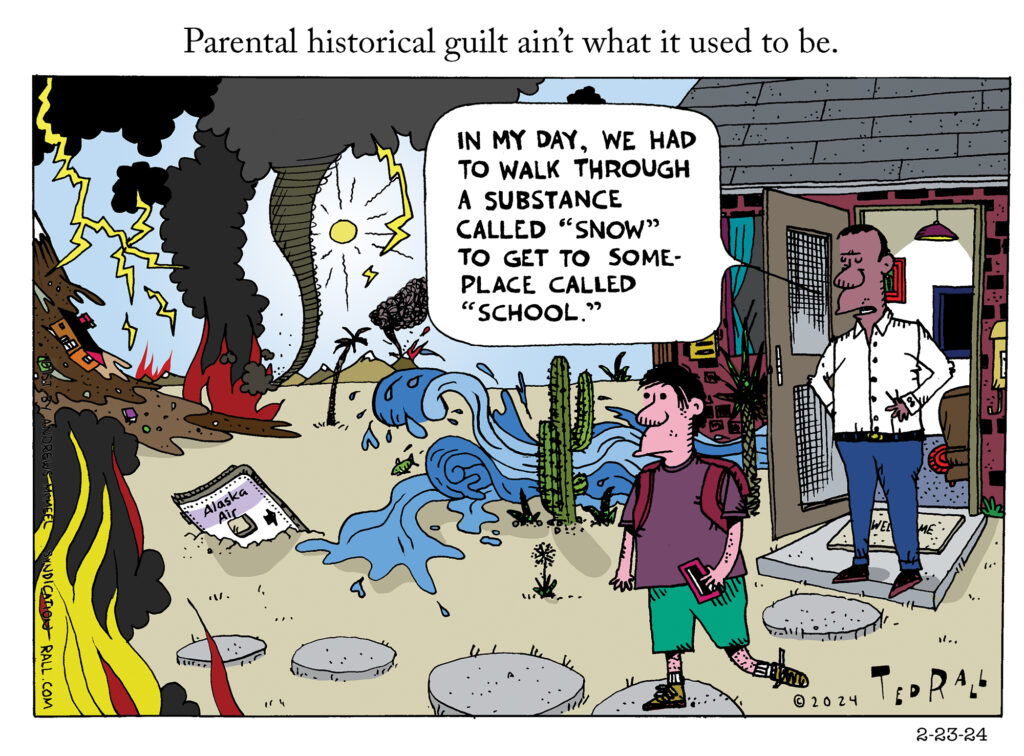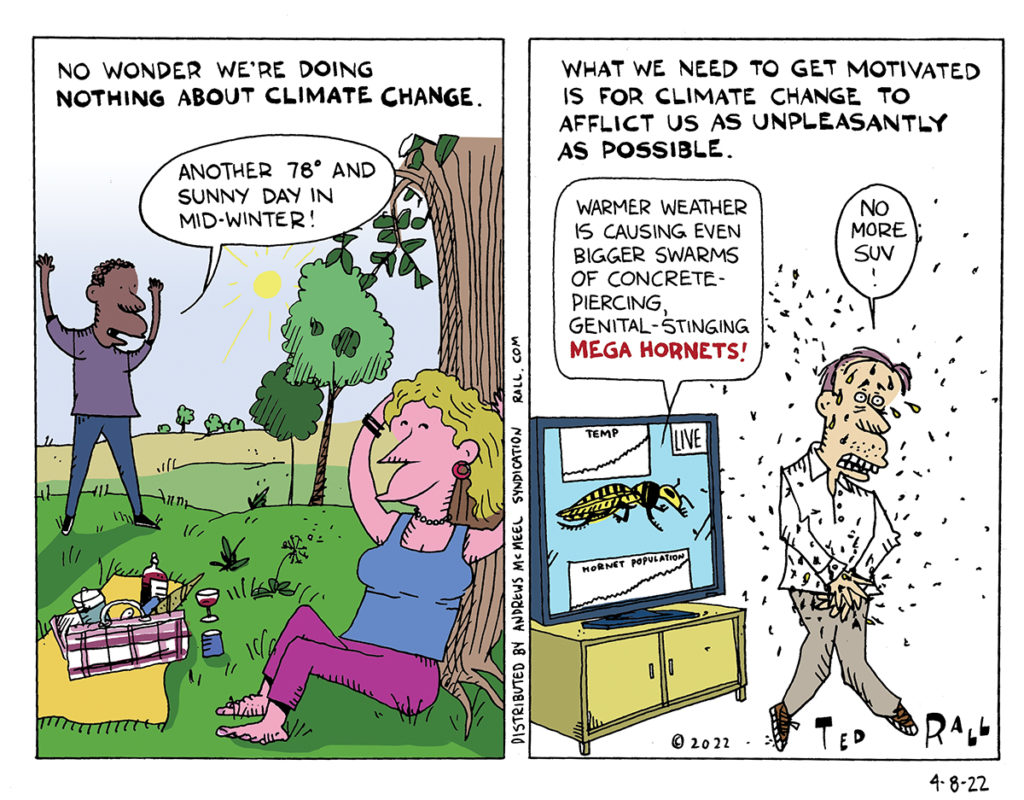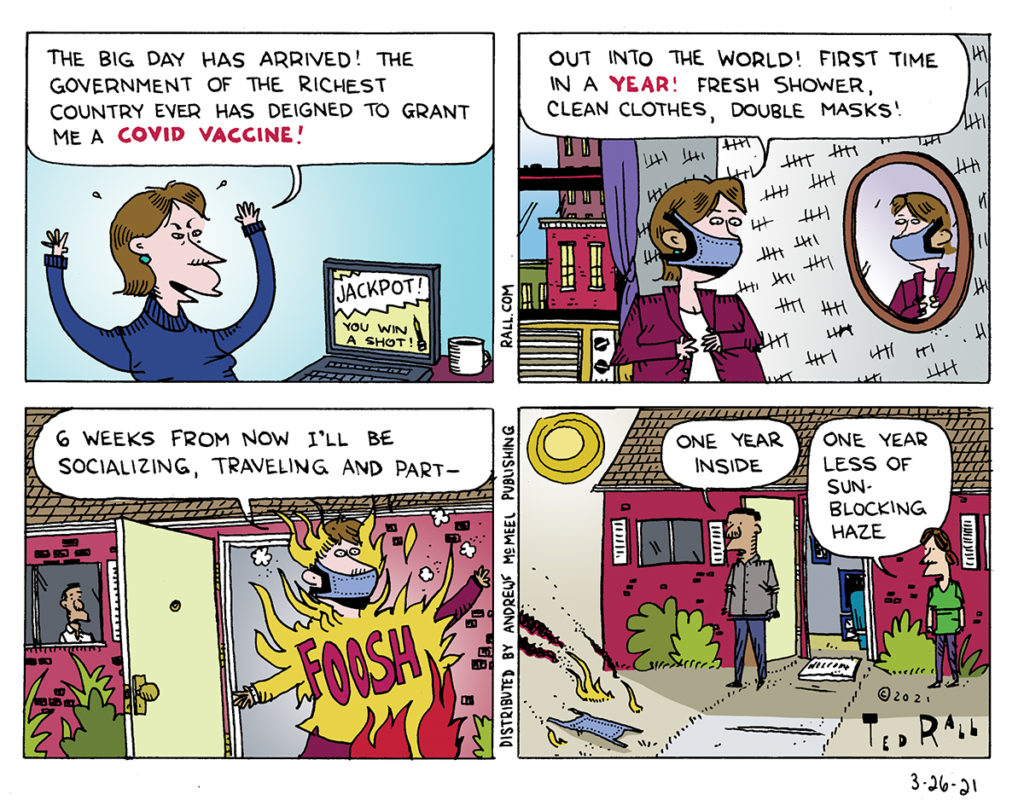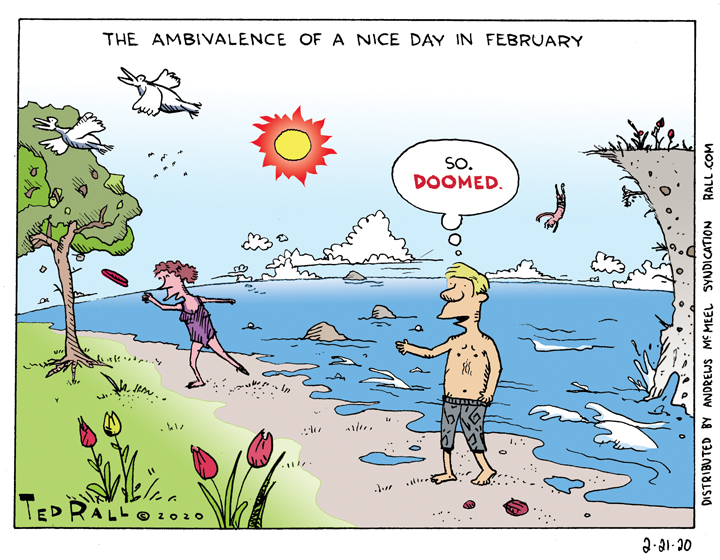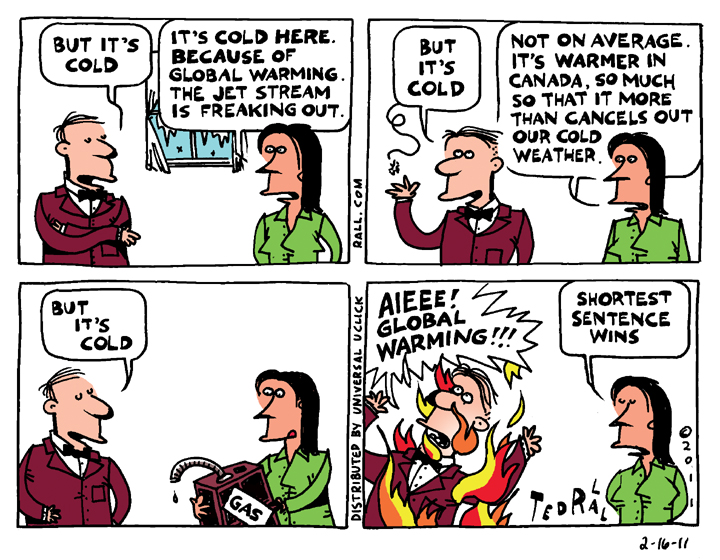Parents used to try to diminish their children’s complaints about dealing with inclement weather by claiming that they had it even worse when they were young. Climate change renders that time-honored tactic impractical.
We Came, We Dithered, We Died

“We believe that the damage done to the ocean in the last 20 years is somewhere between 30 per cent and 50 per cent, which is a frightening figure. And this damage carries on at very high speed—to the Indian Ocean, to the Red Sea, to the Mediterranean, to the Atlantic…Everywhere around the world the coral reefs are disappearing at a very great rate, to such an extent we are not sure we will see anything like what we know now.”
Jacques Cousteau wrote these words in 1971, for an New York Times op-ed titled “Our Oceans Are Dying.”
No one listened.
No one cared.
No one did anything. So now, as Cousteau warned us would happen, our oceans are finished.
More than 90% of coral reefs on Earth will be dead in the next 25 years. What if we did…something? No. Reef extinction is irreversible, even if we were to stop emitting greenhouse gases right this second.
96% of all ocean life, fish big and small and everything that swims, will be gone as well. There’s nothing we can do to save them.
The cause is obvious and well-known: rapid and extreme global warming caused by humans, pollution and overhunting. We don’t have to look far to see that the ocean is boiling: at this writing, water temperatures off the Florida Keys have reached 97°. Caribbean waters are normally 82° all year around. The surprise isn’t that 96% of the ocean life is doomed, it’s that 4% may not be.
It will be soon.
Ironically, all this heat is about to start a new Ice Age. A new study concludes that there is a 95% chance that the Atlantic Meridional Overturning Circulation (AMOC), a system of ocean currents including the Gulf Stream that carry warm water from the tropics into the North Atlantic will collapse between 2025 and 2095 because it is being blocked by cold water dumped into the northern part of the ocean from melting glaciers and ice caps. Without the AMOC, as soon as two years from now and no later than 70, Europe will be buried under sheets of ice, like in the disaster movie “The Day After Tomorrow.”
Bummer. I liked Europe.
Several years ago, flying west from Istanbul to New York, my plane’s pilot announced that he and his colleagues could see that the Gulf Stream was breaking down—and had been for some time. As a result, we’d arrive earlier than scheduled. He explained why this was scary. He urged us to write our Congressmen. I wonder if anyone on board did. I didn’t. What would have been the point? Congress doesn’t care or help or act.
In a natural-disaster movie like “2012” or “Armageddon,” the world’s political and business leaders gather in a blue-lit situation room chock full of computer screens displaying cool infographics, some in business attire, others in exotic garb, all wearing somber holy-crap expressions as the camera pans around. Someone, either the U.N. Secretary General or the U.S. President (these are American movies), calls on nations to drop everything, set aside their differences and dedicate all their resources and attention to the existential crisis of climate change, the worst threat—by far—that humanity has ever faced.
Because this is a film, where politicians are sometimes evil but never total idiots, everyone nods in agreement, rolls up their sleeves and gets to work to save humanity’s ass.
(In the European version of this film, we all die in the end after waging a valiant and noble struggle.)
Actual politics, however, are not as logical or commonsensical as movies. Young people like the activist Greta Thunberg are, quite reasonably, appalled at the mess they’ve inherited thanks to decades of dithering: “Pretty much nothing has been done since the global emissions of CO2 has not reduced,” Thunberg told a 2020 climate conference. “[I]f you see it from that aspect, what has concretely been done, if you see it from a bigger perspective, basically nothing.”
I ask my smart friends why we’re so stupid. “It’s all about money,” they usually say, more or less. “Business and rich individuals profit from the current system.” But that doesn’t make sense. There’ll be no economy if we’re all dead. You can’t enjoy your wealth if you’re dead. Being dead, all of us as a result of environmental catastrophe, is a distinct possibility—for our grandchildren, our children, even for precious Us.
And yet—my smart friends are right. Capitalist idiots are so moronically capitalist that they’d rather be rich and dead than middle class and alive. The rest of us, the non- and anti-capitalist people who neither benefit from ecocide nor approve of it, are letting the greedy lunatics take us with them. We are, precisely because we believed Jacques Cousteau and did nothing to act or to react or to resist, even dumber than they are.
Darwin wins again.
(Ted Rall (Twitter: @tedrall), the political cartoonist, columnist and graphic novelist, co-hosts the left-vs-right DMZ America podcast with fellow cartoonist Scott Stantis. You can support Ted’s hard-hitting political cartoons and columns and see his work first by sponsoring his work on Patreon.)
How We Will Finally Get Serious about Climate Change
Climate change/global warming is an existential threat to humanity. But the main effect of it, warmer weather, is repeatedly reported as something positive. What we really need to be spurred into action is a seriously painful development.
In Praise of Bad Weather

There is joy in the air. That joy is misplaced.
For that joy might kill us.
I set down these words on the 9th of March in Manhattan. Historically, the average temperature on this day of the year is 40°. If the weather forecast for today, March 9, 2021, is correct, and at this writing it looks like it will be, the temperature will hit 61°.
“Today is going to be a beautiful day,” the radio said this morning.
Everyone is happy. People are making plans to eat outside, go running, walking, whatever, everyone in New York who can break away from work or other obligations is determined to enjoy today’s “good weather.”
I feel it too. I have a meeting after I finish writing this. The sun will feel sweet on my face. More people will be smiling; even if I have to surmise that from the twinkle in their eyes above a mask, their pleasure in this good weather will be infectious.
We have got to stop thinking about warm, sunny, hotter-than-usual weather as positive. Weather isn’t climate. But hotter-than-usual weather multiplied out, repeated as it has been for years, reflects the existential threat of climate change. Hotter-than-usual weather repeated over time is killing coral and plants, extinguishing species of animals. It will ultimately kill us, and if not us, our children, and if not them, our grandchildren. I have not yet met my grandchild, but I don’t want my grandchild, or yours, to die before he or she has his or her own grandchildren.
We’ve been greeting “beautiful days,” i.e. hotter-than-usual days, by pulling on tank tops, grabbing picnic baskets and heading to the park. This is understandable. This is insane.
Celebrating a hotter-than-usual day makes as much sense as a Frenchman jumping for joy at the sight of invading German troops. Sparkling blue, cloudless skies are harbingers of doom. The soft scent of your own sweat under a gentle sun in mid-winter is a death sentence handed down by a judge whose rulings cannot be appealed. When you hear that it’s going to be 61° in Manhattan in March, you should be scared to death.
There are, if you pay attention, signs that everything is wrong. Trees whose first buds appeared in late April now pop out in February, fresh leaves frozen off as the weather turns cold again, though not as cold nor for as long as it should. Asthmatics, those human canaries, suffer from “spring” allergies all “winter” long. There are so few birds.
The proper response to one too many hotter-than-usual days in mid-winter — for that matter, it is also an appropriate way to greet a series of hotter-than-usual days in summer — is fear. We are on the way out. We are killing ourselves. This is seriously messed up.
Anger follows fear. We should hate the ecocidal maniacs who are too greedy and stupid to see that their relentless quest for short-term corporate profits is murdering us. We should despise the politicians who sell us out to these psychos. We should be ashamed of ourselves for tolerating both sets of crazies.
Unless we are idiots, action should come next, and damned soon. The truly great thing about a 61° day in New York City in March (in March!) is that it makes it more enticing for hundreds of thousands of New Yorkers together in public spaces to protest and demand sanity from their overlords. There are no winter coats or cold-stiffened bones to stop demonstrators from hurling teargas canisters back at the cops.
Saving ourselves must begin with a mental shift.
There is, as an older gentleman who drove me in his taxi told me a couple of years ago, no good weather or bad weather. There is only weather. To a farmer, rain is often welcome. To which I would add, given the context of global warming, there is only appropriate weather — appropriate to its time and place and based on the assumption, which needs to become true if we want to live, that the human race is no longer affecting that weather.
An 80° day at the South Pole might be pleasant for sunbathing scientists. But it would be radically inappropriate regardless of the time of year. A 20° day in Bali might be fun for Indonesians who’ve never been in a snowball fight. But it would be wildly wrong, allowing for normal variations of high and low.
I come to you in praise of “bad” weather. On the 9th of March, New Yorkers ought to be happy to see sleet. They should smile at their neighbors as they tiptoe through filthy slush puddles pooled at the street corners. Climate change has turned the world topsy-turvy; in a topsy-turvy world, good weather is bad and bad weather is good.
(Ted Rall (Twitter: @tedrall), the political cartoonist, columnist and graphic novelist, is the author of “Political Suicide: The Fight for the Soul of the Democratic Party.” You can support Ted’s hard-hitting political cartoons and columns and see his work first by sponsoring his work on Patreon.)
SYNDICATED COLUMN: Cut-and-Paste Revolution, Part II
Time for the Occupy Movement to Come In From the Cold
The Occupy movement is an attempt to replicate Tahrir Square in the United States. But you can’t just cut-and-paste a model that (sort of) worked in Egypt to the United States.
Especially when you don’t understand Tahrir.
American media mischaracterized the Tahrir Square political uprising as an ongoing occupation cum encampment. True, poor people from outside Cairo who couldn’t afford hotel rooms slept in the Square throughout the rebellion against soon-to-be ex-president Hosni Mubarak. However, most of the tens and hundreds of thousands of demonstrators whose nonviolent protest led to the resignation of President Hosni Mubarak came and went throughout the day, often shuttling between their jobs and homes and the square. Unlike the U.S. Occupations, which devote most of their General Assemblies to logistical issues—are the cops coming? will the drummers limit themselves to two hours a day?—Tahrir was a laboratory of democracy where people from different cities, religious and political persuasions met to debate and discuss issues and problems. “Debates rage over the timing of elections, the power of Islamists, the weakness of civilian rulers and the lack of accountability of their military counterparts,” The New York Times reported on July 12th.
Other things are different. For example, Chicago is a lot colder than Cairo.
From a communiqué issued by Occupy Los Angeles: “Also, there is a movement going asking people to dress nicely—they are calling it ‘khakis and a polo.’ By day, that makes sense, but dress warmly for night time! Hypothermia is dangerous.”
Hypothermia? Not a huge concern under the palm trees of southern California. At this writing the daytime high is 20 degrees Centigrade and the nighttime low is 14. But the weather is a serious issue for much of the country. The mercury is dropping throughout the northern United States. Winter is on the way.
What will happen to OccupyMN in Minneapolis? OccupyMNers marched to local banks and the regional branch of the Federal Reserve to demand a moratorium on housing foreclosures in particular and lower income inequality in general. They’re living in tents near the local Government Center. Freezing temperatures will arrive in a week or two. Snowfalls of two and three feet are not uncommon. How long will the Occupiers of cold-weather cities like New York, Boston and Seattle last in their tents and sleeping bags?
Interestingly, the U.S. Parks Police-issued four-month permit for Stop the Machine (the Washington occupation on which the Occupations were originally modeled) expires in February.
The authorities are playing this like Russia when it was invaded by France and Germany: Retreat now, let the winter freeze the bastards out.
If the northern Occupations (which are the heart of the movement) are to survive the winter, they must move indoors. This will ratchet up the tension with the authorities. Which is the obvious next step anyway.
Occupy has to come inside. To avoid frostbite. And to avoid stagnation.
Movements move.
Occupy Albany is thinking about moving into New York’s state capitol building. There are countless options. Government offices, bank offices and branches, mortgage companies, colleges and universities with unsavory relationships to the top 1% who are screwing over most Americans—all are obvious candidates for occupations. Not to mention the millions of homes all over the country that have been vacated by illegal and immoral bank foreclosures.
The Nation notes that New York has many privately owned public spaces, including the atriums of buildings owned by Donald Trump, IBM and Citigroup. “These locations may not be altogether practical for the occupiers, and in fact protesters would likely face strong resistance from the properties’ owners if they were to try to hold any of these plazas and atriums,” writes Francis Reynolds. “But the fact that most of these privately owned public spaces are in the lobbies of banks and corporations is a powerful metonym for the way money is shaping our cities and our society. If Zuccotti falls, where will the occupation move next?”
So far, this question has been raised—only to be abandoned in favor of less pressing tangents at the major general assemblies. Occupy Wall Street can’t get it together long enough to set a drum circle schedule.
OWS must remain dynamic in order to survive. So a change of address would probably for the best. They need to stay warm. More importantly, they need to make a militant political statement. That hasn’t happened yet.
In repressive Arab states like Bahrain and Egypt, the mere act of appropriating a centrally-located public space to express discontent over a prolonged period was seen by the regime and their subjects alike as provocative and confrontational. Not so much in the U.S.
Wiggly fingers at general assemblies and arrest-by-the-numbers at non-threatening (in)actions aren’t going to cut it in this second phase.
Many of the young hipsters have gone home. Now OWS is substantially populated by the habitually homeless. Filth and smelly bodies abound.
It made sense to invite the most dispossessed Americans to join a movement dedicated to eradicating economic injustice. But openness has caused problems. “Now, protesters from Portland to Los Angeles to Atlanta are trying to distinguish between homeless people who are joining their movement and those who are there for the amenities,” reports the Associated Press. “When night falls in Portland, for instance, protesters have been dealing with fights, drunken arguments and the display of the occasional knife. One man recently created a stir when he registered with police as a sex offender living in the park. A man with mental health problems threatened to spread AIDS via a syringe. At night, the park echoes with screaming matches and scuffles over space, blankets, tents or nothing at all.”
At Occupy Wall Street discussions have been replaced by vacuous sloganeering in the form of politics (“end the fed,” “we are the 99%,” etc.)—nothing close to the energy of the ideological incubator of Tahrir Square. “What specifically are you protesting?” sympathetic New York Times columnist Charles Blow asked an OWS participant “I don’t know. It’s just cool,” she answered.
On a recent visit I found about 150 full-time OWSers, another 100 or so floating supporters, and at least 300 or 400 tourists running around snapping photos of signs and assorted freaks. And lots of foreign journalists. Everyone thought it was cool.
Cool is cool. But it ain’t revolution yet. Revolution is dangerous. No danger; no change.
OWS has become comfortable. The authorities have become comfortable with OWS. But that’s about to change.
If and when Occupiers move into indoor space, they may have to abandon their current strict adherence to nonviolent tactics. Unless they offer resistance, the state—guardian of corporate interests—will simply drag them out of The Donald’s atrium and off to jail.
OWS and its progeny will certainly go down in history as the first salvo of a nascent American revolution. Whether the Occupy movement survives to participate in what comes next (as opposed to serving as an interesting historical antecedent whose mistakes will be studied by future, more successful efforts), or whether anything will come next, will depend on whether they are willing to disrupt governmental and corporate activity—and assume greater risks.
Which doesn’t necessarily mean engaging in violent acts. But it does require courting a violent reaction from the authorities.
David Galland of the Casey Research blog sneers: “Like the ‘Free Speech Zones’ now mandatory for anyone caring to express an opposing opinion as presidential motorcades rush by, the Occupy Wall Street folks have allowed themselves to be corralled within the boundaries of a designated protest area, approved by the powers-that-be as suitable for the malcontents. Exposing the extent of the farce, the New York Police force has a portable, extendible watchtower that looms over the park, keeping a Sauron-like eye on the goings-on. That thing would have lasted about ten minutes back in the good old brick-throwing days. If I learned nothing back in the Sixties, it is that (once you decide on an objective) you need to assemble in the spot that most forcibly gets your point across—by disrupting business as usual—until the government has no choice but to arrest you, after which you return to same scene and repeat until someone gives. You win if the other guy blinks. Were I trying to discomfit Wall Street, I’d be blocking the doors of the major financial houses.”
In other words, no more four-month permits.
Right-wing radio talk personality Glenn Beck warns the establishment: “Capitalists, if you think that you can play footsies with these people, you’re wrong. They will come for you and drag you into the streets and kill you…they’re Marxist radicals…these guys are worse than Robespierre from the French Revolution…they’ll kill everybody.”
Maybe.
Beck may be able to see further down the road than the OWSers—some of whom are sucking up to the cops who abuse them by saying they’re part of the 99% too—can see themselves. Wayyy down the road.
The Occupiers need a warm place to sleep before they begin feeding banksters to the guillotine.
(Ted Rall is the author of “The Anti-American Manifesto.” His website is tedrall.com.)
COPYRIGHT 2011 TED RALL

